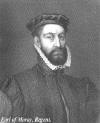|
James
Stuart, `Lord James`.

The
Reformation had many prominent persons that helped shape
the establishment of the Protestant – Presbyterian, Church
in Scotland. James Stuart, Earl of Moray was possibly the
most eminent layman who, like
Erskine of Dun, was a mediator and conciliator at
times of crisis.
James
Stuart was born about 1531, a natural son of James
V, and on his father`s side, brother to Mary Queen of
Scots. Known as simply `Lord James` until elevated to the
Earldom, his mother was Margaret, the daughter of
John, twelfth Lord Erskine, fifth Earl of Mar. She later
married Sir Robert Douglas, laird of Lochgoin. As was the
practice of the time, James was given the ecclesiastical
benefice of Lord Prior of St Andrews at the age of
three. The revenues from the post he continued to receive
until he was created Earl of Moray, on 10 February 1561/2.
His first direct contact with the evangelism of John Knox
was when the latter preached at Calder in 1555. He would
have learnt also from associating with other like minded
nobles such as the Earls of Argyll, Glencairn, the Lord of
Lorne and Erskine of Dun. He and Argyll wrote to Knox
inviting him to return to Scotland in 1556.
Being of
royal blood, James was at the heart of Court affairs and
for some time he was a loyal servant to the Regent, Mary
of Guise, widow of James V. As a staunch Catholic Mary was
bent on maintaining Popery and intolerant of the free
speaking evangelists. She
summoned four preachers—Paul Methven, John Christison,
William Harlow, and John Willock—to Stirling to answer
charges of usurping the ministerial office and preaching
sedition. Methven had preached at the first formal
Reformed Congregation meeting in Dundee and had a part in
a remonstrance to the Regent petitioning for reform in the
Church and the State, including hearing religion in the
Scots tongue. Mary first agreed that a meeting could be
held outside of Edinburgh, then changed her mind and
called their meeting an illegal conventicle. Against this
background there were concerns for the trial of the four
preachers which had been appointed for 10 May 1559.
Their many
supporters therefore assembled in Perth with the intention
of accompanying them to Court. Knox meanwhile returned to
Scotland on 2 May in time to join the gathering, and add a
new impetus. Lord James and Argyll were sent by the
Regent to ascertain the circumstances and purpose of
the congregation assembled in Perth to which Knox sent a
challenging reply .
“That
her enterprise would not prosper in the end, seeing that
she intended to fight against God“.
Regent
Mary`s response was to order the gathering to disperse
from Perth, but she had to agree to give them time to
leave peaceably because of the great numbers. The
gathering broke up and went its way, but Mary then turned
on Perth aided by French troops and loudly proclaimed
that “no faith should be kept with heretics”. When the
preachers did not compear at Stirling (seemingly because
they had previously been dismissed) the Regent
declared them to be rebels and imposed fines on their
sureties. The treacherous treatment of the preachers
raised the temperature considerably, enraging both the
professors of Protestantism and the populace. The
following day, 11 May, Knox preached in Perth, and a boy
threw a stone at an idol on the altar of a church – the
rabelling of the churches and monasteries began.
The outcome
of the breaches of faith by the Regent was that Lord James
and Argyll both joined the Lords of the Congregation, and
signed the Perth Covenant of 31st May 1559. They then
invited the leaders of the movement to a meeting at St
Andrews on 3 June, bringing with them 3000 men at arms –
sufficient to fend off the Regent`s French guard and the
armed supporters of the Archbishop of St Andrews.
The Regent called it rebellion and alleged that there was
a plot to place Lord James on the throne, even resorting
to forging letters from Francis II, King of France, and
wife Mary (Queen of Scots) upbraiding him for his
ingratitude. James responded to the letters firmly, saying
that he was unaware of having misplaced loyalties and
stated clearly his support for the reformation of
religion.
Over 3,000
French troops were landed at Leith forcing the
Congregation to remove to Stirling. When the French troops
descended on Fife and began pillaging the land, Lord James
and Argyll with about 600 supporters went to Dysart to
confront them. For some twenty four days the valiant
Congregation force contained some 4,000 French troops. It
is said that Lord James and Argyll “never put off their
clothes during the whole time, and slept but little.”
A Treaty with England and the arrival of English troops
forced a truce, followed by a Treaty in July
1560 that saw the end of French influence in Scotland and
the independence of a Protestant Scotland. Meanwhile,
Providence had intervened with the death of Regent Mary
(June 1560) and shortly afterwards King Francis II of
France. This left the young widow, Mary Queen of Scots
free to return to her native Scotland.
Next:
Regent Moray
|